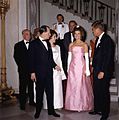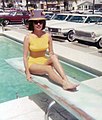1960s in fashion
From Wikipedia, the free encyclopedia
The 1960s featured a number of diverse trends. It was a decade that broke with many fashion traditions that mirrored social movements during the period. In the middle of the decade, culottes, box-shaped PVC dresses and go-go boots were in style. The widely popular bikini came into fashion in 1963 after being featured in the musical Beach Party.
Mary Quant invented the mini-skirt, which became extremely popular throughout the 1960s. The hippie movement late in the decade also exerted a strong influence on braless ladies' clothing styles, including bell-bottom jeans, tie-dye, and batik fabrics, as well as paisley prints. The Beatles and Timothy Leary popularized the Nehru jacket, named for Jawaharlal Nehru, India's first Prime Minister, which had a short-lived popularity in 1967.

Contents[hide] |
[edit] Early 1960s
Fashions in the early years of the decade reflected the elegance of the First Lady Jacqueline Kennedy. In addition to the pillbox hat which is discussed in detail below, women wore suits, usually in pastel colours, with short boxy jackets, and oversized buttons. Simple, geometric dresses, known as shifts, were also in style. For evening wear, full-skirted ballgowns were worn; these often had a low décolletage and had close-fitting waists. For casual wear, capri trousers were the fashion for women and girls.
Stiletto-heeled shoes were widely popular.

[edit] The mid 1960s
After designer Mary Quant introduced the mini-skirt in 1964, fashions of the 1960s were changed forever. The mini was eventually to be worn by nearly every stylish young female in the western world.
The mini dress was usually A-line in shape or a sleeveless shift[1].
In 1964, French designer Andre Courreges introduced the "space look", with trouser suits, white boots, goggles, and box-shaped dresses whose skirts soared three inches above the knee. These were mainly designed in fluorescent colours and shiny fabrics such as PVC and sequins.[2]
The leaders of mid 1960s style were the British. Carnaby Street and Chelsea's Kings Road were virtual fashion parades. In 1966, the space age was gradually replaced by the Edwardian, with the men wearing double-breasted suits of crushed velvet or striped patterns, brocade waistcoats, shirts with frilled collars, and their hair worn below the collar bone. Rolling Stones guitarist Brian Jones epitomised this "dandified" look. Women were inspired by the top models of the day which included Twiggy, Jean Shrimpton, Colleen Corby, Penelope Tree, and Veruschka. Velvet mini dresses with lace-collars and matching cuffs, wide tent dresses and culottes had pushed aside the geometric shift. False eyelashes were in vogue, as was pale lipstick. Hemlines kept rising, and by 1968 they had reached well above mid-thigh. These were known as "micro-minis". This was when the "angel dress" made its appearance on the fashion scene. A micro-mini dress with a flared skirt and long, wide trumpet sleeves, it was usually worn with patterned tights, and was often made of crocheted lace, velvet, chiffon or sometimes cotton with a psychedelic print such as those designed by Emilio Pucci. The cowled-neck "monk dress" was another religion-inspired alternative; the cowl could be pulled up to be worn over the head.[3] For evening wear, skimpy chiffon baby-doll dresses with spaghetti-straps were the mode as well as the "cocktail dress", which was a close-fitting sheath, usually covered in lace with matching long sleeves.[4]Feather boas were occasionally worn.
In 1964, Bell-bottomed trousers were a new alternative to the capris of the early 1960s. They were usually worn with chiffon blouses, polo-necked ribbed sweaters or tops that bared the midriff.
For daytime outerwear, short plastic raincoats, colourful swing coats and dyed fake-furs were popular for young women. In 1967, the Nehru jacket arrived on the fashion scene, and was worn by both sexes.
Footwear for women included low-heeled sandals and kitten-heeled pumps, as well as the trendy white go-go boots. Shoes, boots, and handbags were often made of patent leather or vinyl. The Beatles wore elastic-sided boots similar to Winkle-pickers with pointed toes and Cuban heels. These were known as "Beatle boots" and were widely copied by young men in Britain.

[edit] The late 1960s
By 1969, the androgynous hippie look was in style. Both sexes wore frayed bell-bottomed jeans, tie-dyed shirts, workshirts, and headbands. Wearing sandals or going barefoot was also part of the hippie look. Many young women opted to go braless.
Fringed buck-skin vests, flowing caftans, Mexican peasant blouses, gypsy-style skirts, scarves, and bangles were also worn by teenage girls and young women. Indian prints, batik and paisley were the fabrics preferred. For more conservative women, there were the "lounging" or "hostess" pyjamas. These consisted of a tunic top over floor-length culottes, and were usually made of polyester or chiffon.
Another popular look for women and girls which lasted well into the early 1970s was the suede mini-skirt worn with a French polo-neck top[5], square-toed boots, and Newsboy cap or beret. Long maxi coats, often belted and lined in sheepskin, appeared at the close of the decade.[6]Animal prints were also popular for women in the autumn and winter of 1969. Women's shirts often had transparent sleeves.

[edit] Hairstyles
Head coverings changed dramatically towards the end of the decade as men's hats went out of style, replaced by the bandanna, if anything at all. As men let their hair grow long, the Afro became the hairstyle of choice for African Americans. Mop-top hairstyles were most popular for white and Hispanic men, beginning as a short version around 1963 through 1964, developing into a longer style worn during 1965-66, eventually evolving into an unkempt hippie version worn during the 1967-69 period which continued in the early 1970s. Facial hair, evolving in its extremity from simply having longer sideburns, to mustaches and goatees, to full-grown beards became popular with young men from 1966 onwards. Women's hair styles ranged from beehive hairdos in the early part of the decade to the very short styles popularized by Twiggy just five years later to a very long straight style as popularized by the hippies in the late 1960s. Between these extremes, the chin-length contour cut and the pageboy were also popular. The pillbox hat was fashionable, due almost entirely to the influence of Jacqueline Kennedy, who was a style-setter throughout the decade.


[edit] Additional fads and trends
The '60s also gave birth to the skinny jean, (slim-fit pants), worn by Audrey Hepburn, which is again popular with young women today.
In Britain the Mod subculture was a fashion phenemenon with their trademark anorak jackets, tailored Italian suits, and scooters. Their rivals, the Rockers, instead wore the same black leather jackets, Levi jeans, and pompadour hairstyles worn in the 1950s.
Ponchos, mocassins, love beads, peace signs, medallion necklaces, chain belts, polka dot-printed fabrics, and long, puffed "bubble" sleeves were additional trends in the late 1960s.
New materials other than cloth (such as polyester and PVC) started to become more popular as well.
[edit] Image gallery
|
A selection of images representing the fashion trends of the 1960s:
|
Singer and actress Barbra Streisand in 1962 wearing a top with a crew-neck. Her hair is teased at the crown. |
First Lady Jacqueline Kennedy wearing a strapless pink evening gown and elbow-length white gloves. She was a fashion icon in the early 1960s |
|
|
Actress Tina Louise in 1964. Her hair is styled into thick, rolled curls piled up on her head. |
Young woman in Florida, 1965. |
American girl wearing a mini skirt and patterned tights, 1966. |
The Mods were a fashion phenomenon in Britain in the mid-1960s with their anoraks, Italian tailor-made suits, and scooters |
|
Biba's in Kensington, London, was one of the trendiest shops in the 1960s. |
Young woman wears her hair in a pageboy flip, 1967. |
Woman at a Singapore zoo, 1967. Note her Pucci-style print dress. |
Family photograph taken in Los Angeles, California, 1968. The man is wearing a medallion necklace. |
|
Swedish man wears the popular "dandified" male fashions. |
Young girl wearing a mini dress and white go-go boots, 1968. |
Two men at the Woodstock Festival, 1969 |
|
|
Girl in late 1969 wearing a tiger-print mini jumper dress and matching beret. |
Boy with a mop top hair cut, 1969. |
[edit] See also
- Oleg Cassini
- Andre Courreges
- Lauren Hutton
- Veruschka
- Jean Shrimpton
- Penelope Tree
- Twiggy
- Celia Hammond
- Mod (lifestyle)
[edit] References
- ^ PaperpastYearbook,www.paperpast.com/html/1960 _fashion.html
- ^ Fashion From Ancient Egypt To The Present Day, by Mila Contini, page317
- ^ Paperpast Yearbook, www.paperpast.com/html/1960_fashion.html
- ^ Contini, page 317
- ^ Paperpast Yearbook, www.paperpast.com/html/1960_fashion.html
- ^ Paperpast Yearbook,www.paperpast.com./html/1960_fashion.html
- Fashion From Egypt To The Present Day, by Mila Contini Crescent Books New York
[edit] External links
| Wikimedia Commons has media related to: 1960s fashion |
- Paperpast yearbook (1966)
- "1960s Fashion and Textiles collection". Fashion, Jewellery & Accessories. Victoria and Albert Museum. http://www.vam.ac.uk/collections/fashion/1960s/index.html. Retrieved on 2007-06-08.
- "60s Fashion in the Round". Fashion, Jewellery & Accessories. Victoria and Albert Museum. http://www.vam.ac.uk/collections/fashion/features/round/rotations/index.html. Retrieved on 2007-12-09.
link 60s Supermodels on the Web
|
|||||||||||||||||||||||||||||||



















